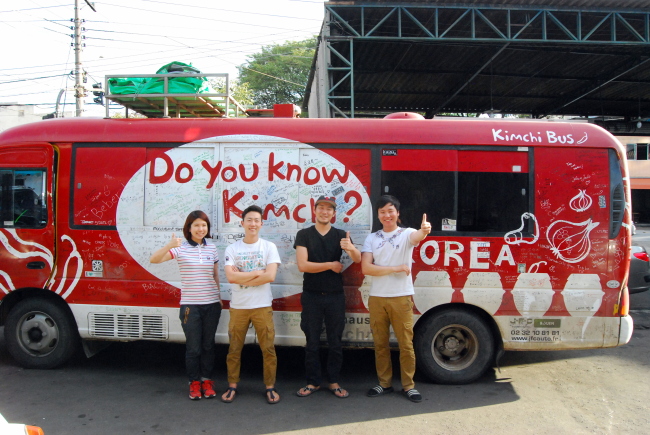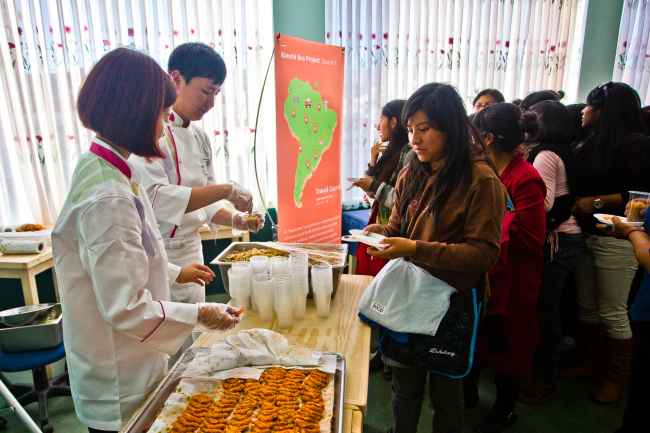Last stop on the Kimchi Bus
Four Koreans cross Latin America with kimchi and sense of adventure
By Korea HeraldPublished : Aug. 17, 2014 - 20:51
SAO PAULO ― Traveling around a foreign continent for 100 days is challenging enough. Throw in a tight schedule, a rickety old minibus and a fridge full of fermented cabbage, and you have yourself a Kimchi Bus tour.
After two road trips through more than 140 cities in Europe, Russia, North America, Japan and Korea since 2011, the little red bus is on its third and final adventure ― to Latin America, where its team is seeking out the origins of the chili pepper that gives kimchi its spicy zing.
They visit language schools, culinary institutes, cultural events and sometimes sidewalks, parks and beaches, sharing their culture through kimchi everywhere they go.
“I studied cooking, I like traveling and I like taking pictures, so I can do everything with this Kimchi Bus. This is my goal and my dream,” project mastermind Ryu Si-hyeong told The Korea Herald during their stop in Sao Paulo’s Koreatown. Nearby they had served kimchi at the K-Food festival, a Korean cultural festival set up when South Korea played Belgium during the World Cup.
After two road trips through more than 140 cities in Europe, Russia, North America, Japan and Korea since 2011, the little red bus is on its third and final adventure ― to Latin America, where its team is seeking out the origins of the chili pepper that gives kimchi its spicy zing.
They visit language schools, culinary institutes, cultural events and sometimes sidewalks, parks and beaches, sharing their culture through kimchi everywhere they go.
“I studied cooking, I like traveling and I like taking pictures, so I can do everything with this Kimchi Bus. This is my goal and my dream,” project mastermind Ryu Si-hyeong told The Korea Herald during their stop in Sao Paulo’s Koreatown. Nearby they had served kimchi at the K-Food festival, a Korean cultural festival set up when South Korea played Belgium during the World Cup.

The fearless foursome ― Ryu, his fellow Kyung Hee University alumnus Kim Seung-min, video guy Lee Kyu-ho and Spanish translator Kim Su-a ― are in the third “season” of the Kimchi Bus, filming their travels through Peru, Bolivia, Brazil, Uruguay, Argentina and Chile from May to August. At each stop, they demonstrate kimjang (the process of how kimchi is made), present the layout of a traditional Korean meal and give locals a taste of Korea’s favorite fermented dish.
They live, eat and sleep in the Kimchi Bus, bathing outside with their 200-liter water tank whenever they can. Just like at home, they take their shoes off at the door and have a regular-sized rice cooker. Also perhaps just like at home, much of the space is taken up by a giant kimchi fridge.
It took three years to get the sponsorship to afford a bus for the first tour through Europe and Russia, and this year was not much easier. Even though sponsor logos are put on the brochures and the side of the bus, it was a challenge to get sponsors when there’s no profit to be had. All the team wants to do, according to Ryu, is travel, make friends with the locals and “naturally promote” Korean culture.
“There is no mission,” Ryu said. “I always say, we aren’t promoting food. We’re just travelers. When we get somewhere we can promote, because it’s kind of a cultural conversation. It is more natural and easy.”
But this trip was helped by the rising global popularity of K-pop, thanks especially to a certain “Gangnam Style” horse-rider. “We usually follow K-pop. Everyone knows Psy,” he said. “Because of Psy, they know about Korea and want to know about Korean culture.”
In fact, K-pop is the first thing people know about Korea, he notes. Their first stop was to a Korean language school in La Paz, where kids wanted to study the language to know song lyrics better, and their last leg before returning to Peru included a K-pop festival in Chile.

Despite his background in culinary science, Ryu doesn’t try to fuse the Korean staple with the local cuisine. He realized people wanted a taste of authentic cuisine, so the Kimchi Bus presents a la Korean bapsang, in small side dishes as it would be served at a traditional table.
And the kimchi itself? Contrary to his expectations, many South Americans find the Korean dish to be spicy, Ryu says.
“Some people say it’s a little spicy. I thought that because chili is popular in Mexico that everyone in South America would love spicy food,” he said. “But maybe only half of them do.”
The chili actually originated in Mexico ― in North America ― before Spanish and Portuguese traders brought it to Asia. Only after the spice was introduced to Korea via Japanese invasions in the 16th century did kimchi’s red variants become a mainstay, according to historians. Compared to Mexico, chili isn’t as heavily adopted in South America, where salty and sugary seasonings are popular from European influence.
This tour has been the hardest, as many challenges took them by surprise. They found it impossible to import their own kimchi from Korea, forcing them to stock up in Koreatowns in Peru and Argentina, and they had to leave their store of gochujang chili paste at a border-town post office before entering Brazil, to the dismay of sponsor Sunchang. On top of strict customs regulations, the car is getting older by the kilometer, not to mention the language barriers and the fact that South America is really, really big.
“It’s totally harder than the second season. The second season was like a picnic,” Ryu said of the previous tour through Korea and Japan. Covering 1,000 kilometers looks easy on a map, he noted, until factoring hills and poorly paved roads with a 16-year-old bus.
Working within the budget and dealing with mechanical difficulties have been the biggest challenges. They’ve had to cancel appearances at schools and other events because of setbacks with the bus. Indeed, arranging to meet the Kimchi Bus team involved a chase through Brazil that finally ended in a parking lot in Sao Paulo.
Ryu says they overcome most problems by tapping into the Korean network ― there are more than 110,000 ethnic Koreans in South America ― speaking with locals in English and trusting in the kindness of strangers.
Human kindness always prevailed, and never did they feel in danger. Even when their bus broke down in Bolivia and they had to wait two weeks to replace the engine, the mechanic invited them into his home and fed them for nearly 10 days.
“In South America, they are very friendly. Someone always helps us,” Ryu said. “Everywhere there’s always good people, but very few bad people. And we are good people, we are laughing, open-minded.”
Their biggest lesson has been of perseverance, mostly learned by dealing with the bus. They’ve had to pinch pennies and sometimes eat less to make up for the maintenance costs, or get stuck in the same tiny Bolivian town for days because of engine trouble. Ryu said they could do it all with a level head because experience has taught them how to choose right from wrong.
“For example, when we had a car problem and needed to change the engine, some people might not be able to overcome,” he added. “They might just give up or get a new car, but we didn’t give up. We just found a (solution). We didn’t get disappointed or cry. We are more optimistic because of our experience.”
The 1998 Hyundai County, which was shipped from Korea to Peru, is scribbled with messages in Hindi, Japanese, Chinese, English, Spanish, Russian and others by fans from the beaches of California to the mountains of Switzerland. The back of the bus is covered in the flags of countries where the bus has been, which is to stand at 34 countries by the end of this tour.
The team returns to Seoul later this month, and once the bus is shipped back to Korea, Ryu plans to park it for good.
“I’m 32 years old in Korean age, and I need a job because this doesn’t make money,” he said. “We’re going to run another project, seasons 4 and 5, but I’m not going.”
He hopes to open a food truck or bistro near Gangnam Station, where he can dish out fusion tacos, fries or kimchi-based delights based on the Kimchi Bus experience. Meanwhile, the Kimchi Bus tradition will live on as he hopes to pass down his knowhow to help younger people to tour through Asia, Europe or North America.
And he says he’s happy with that. He has no regrets about the things he never got to do because he always made his own choices.
“When I travel, I give something up to get something else. You can’t get everything,” he said. “And I always think about what I get. I don’t think about what I sacrifice. It’s a little optimistic.”
Follow the Kimchi Bus on kimchibus.com or facebook.com/kimchibus.
By Elaine Ramirez, Korea Herald correspondent
(elaine@heraldcorp.com)
-
Articles by Korea Herald








![[Kim Seong-kon] Democracy and the future of South Korea](http://res.heraldm.com/phpwas/restmb_idxmake.php?idx=644&simg=/content/image/2024/04/16/20240416050802_0.jpg&u=)








![[KH Explains] Hyundai's full hybrid edge to pay off amid slow transition to pure EVs](http://res.heraldm.com/phpwas/restmb_idxmake.php?idx=652&simg=/content/image/2024/04/18/20240418050645_0.jpg&u=20240418181020)

![[Today’s K-pop] Zico drops snippet of collaboration with Jennie](http://res.heraldm.com/phpwas/restmb_idxmake.php?idx=642&simg=/content/image/2024/04/18/20240418050702_0.jpg&u=)